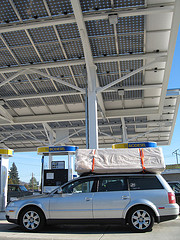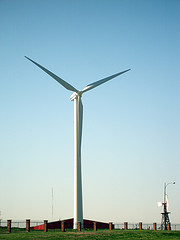Saving the U.S. from Itself: Toward a Rational Energy Policy
By: Amos S. Eno
Posted on:02/17/2011 Updated:02/25/2011Why does the pace of change in energy and transport seem to be zero when we know technology is racing ahead . . . all across our inventive land? -Ken Berlin
This post was prompted when I read one of Ken Berlin’s recent articles, entitled “The Second Valley of Death.” As General Counsel and board member of the Coalition for Green Capital (CGC), Ken is working to rationalize our energy policy in the U.S. As stated in his recent article, while China is aggressively investing in renewable energy and anticipates that one-eighth of its economy will be based on clean energy by 2015, U.S. energy policy stagnates.
“Valley of death” is the trope used by venture capitalists and others to refer to the distance between an invention and its development for the marketplace. Ken’s “second valley of death” refers to the equal difficulty in scaling up and deploying new products profitably in the marketplace even after they have been developed. He cites an example from Shell Oil Co., which stated in 2001 that it has taken an average of 25 years after the commercial introduction of a primary energy form for it to obtain a 1 percent share of the global market.
The Chicken or the Egg?

I first met Ken in 1974; he served on the National Fish and Wildlife Foundation Advisory Board for many years. Ken earned a degree in environmental law in the 70s and has been practicing it ever since. He has served in the Department of Justice, headed the environmental and climate change practices at the law firm of Skadden, Arps, Slate, Meagher & Flom's from 1994 to October 2010, and was Chairman of the Board of four well-known environmental organizations.
But what you really need to know to understand Ken is that he is a bird watcher (as I am). “I’ve been a birder since I was 10. I’ve seen almost 6000 species, so I’m pretty serious about it.” (There are about 10,000 species worldwide). Ken is motivated by his lifelong fascination with birds and his appreciation of nature.
In a nutshell, Ken says there are three problems with current U.S. energy policy:
- high initial prices can prevent new products from achieving competitiveness and the mass market sales that allow lower prices (the chicken and egg problem);
- the inherent risk of any new product;
- lack of a level playing field.
Ken explains the lack of a level playing field this way: “Today, the market fails to take into account the cost of pollution from fuels that emit large quantities of greenhouse gases and to a lesser degree other pollutants. It also fails to take into account the national security risk from reliance on petroleum for transportation.”
What can be done to cross this valley of death? A price on carbon is the obvious answer, but chances of that in the next few years are slim after the defeat of cap and trade in Congress last year. About the CGC’s work on climate legislation last year, Ken says, “we were like Leonardo diCaprio in his role in the film Titanic: ‘we stowed away, we were welcomed to the party, but then we sank with the ship.’”
Toward a More Level Playing FieldNow CGC is starting over again, and they recommend three general policy solutions to address the “second valley of death” problems as they apply to energy technology in the U.S. All of their proposed policies would help lower the price of clean energy for consumers while reducing market, regulatory and infrastructure barriers to its production:
- Provide low-cost financ
 ing and long-term tax incentives that encourage private investment in clean energy. For example, if instead of conventional financing we could provide low-cost, long-term financing for renewable energy, we could reduce the cost of clean electricity and energy efficiency by 15 to 20%.
ing and long-term tax incentives that encourage private investment in clean energy. For example, if instead of conventional financing we could provide low-cost, long-term financing for renewable energy, we could reduce the cost of clean electricity and energy efficiency by 15 to 20%. - Reform energy markets by simplifying regulations without adversely affecting the environment. An example of why the current system does not work: the state of Virginia recently turned down a wind project to protect consumers from a 0.2 percent per KW energy rate increase.
- Provide incentives and minimal federal appropriations to build new supporting infrastructure, which would also create a significant number of new jobs.
At the
Private Landowner Network and some of our
newest state sites, we recognize that the private sector is moving toward clean energy ahead of the government. That’s why we include in our
toolbox numerous calculators and databases designed to help landowners learn how to save electricity; how to locate biodiesel facilities, green building professionals, or innovative energy products; and how to use our award-winning
NRCS Energy Tools for agriculture.
No Action is a Bad ChoiceThe Coalition for Green Capital recently released their first draft of a comprehensive, integrated legislative proposal designed to lead the U.S. toward a clean energy future (download “
CGC Project 2011 Document for Comment”). Ken says, “Climate change raises existential issues for all of us.” A decision not to promote clean energy, he maintains, is a decision that also has some significant negative economic drawbacks:
- other countries have no compunction about providing incentives to promote their fledgling clean energy industries and new businesses;
- without the chance to participate in development and ongoing refinement of these new technologies, the technological ability of U.S. companies will erode;
- there is a strong argument that innovation often follows commercialization and not vice versa (just look at computer chips).
When discussing clean energy, the elephant in the room is always fossil fuel industries. Ken acknowledges that anytime we are replacing an entrenched industry, it’s going to be hard. They have a lot of built-in advantages. Of the two fundamental barriers to clean energy - cost and intermittence - Ken’s solution to the first is to set up investment banks to provide low cost financing for clean energy and energy efficiency, at the state, national and international levels. CGC was successful in getting seed capital funds included in the climate bills last year, $7.5 billion in the House version and $10 billion in the Senate.
“Our ultimate goal,” Ken Berlin says, “ is to change regulations and give the energy industry a different set of incentives.” And with the price of oil rising, classical market incentives should strengthen the worldwide move toward clean energy.
 Sign In
Sign In
 Sign In
Sign In
